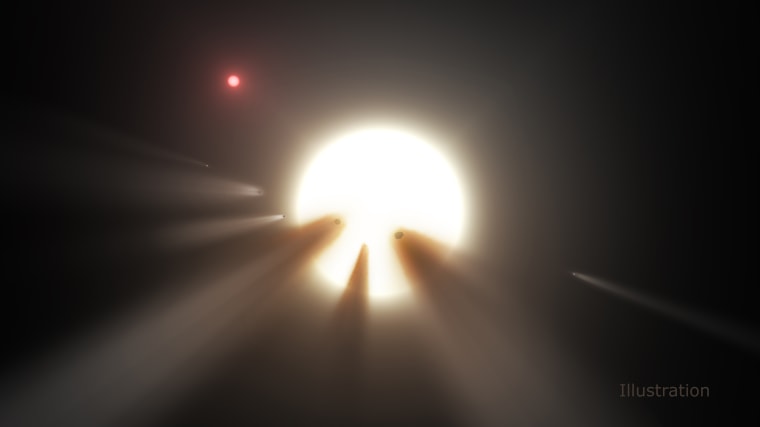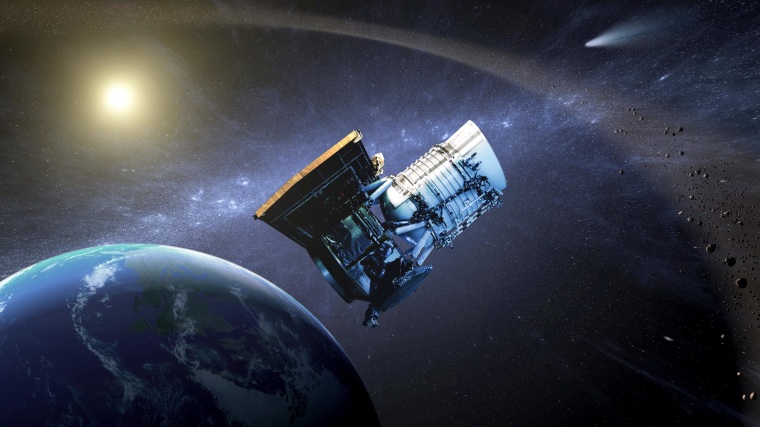Last year, a single star found fame. It consistently made headlines and even appeared on "Saturday Night Live" and "The Late Night Show with Stephen Colbert." The star (often referred to as Tabby’s star) is located 1,200 light-years away toward the constellation Cygnus and has been inexplicably flickering and fading by such large amounts that it cannot be easily explained by natural causes. One astronomer has speculated that it’s encased within a vast alien megastructure, and although scientists have yet to solve that particular stellar mystery, they are continuing to scour the sky in search of these colossal construction projects — both within and beyond our home galaxy.
Related: The 5 Biggest Questions About the Universe
It might sound like science fiction, but as early as 1959 physicist Freeman Dyson surmised that all advanced civilizations — including ours — would eventually build one of these megastructures. He predicted that any civilization could wake up one day to discover that they had consumed all of the energy available on their home planet. At this point, each civilization would naturally look toward their stars, giant nuclear furnaces that release torrents of energy every second, for a solution. Unfortunately, only a sliver of that energy, in the form of light, will fall on any orbiting planet. Most is simply lost to space. So any advanced civilization would likely build a series of solar panels to envelope the star, almost like scaffolding around a church’s dome, collecting every available scrap of the star’s energy and beaming it back toward their home planet.
Today these megastructures are better known as Dyson Spheres, and from an engineering perspective they sound pretty wild. It’s true that a sphere which completely encloses a star is impractical (one asteroid strike or stellar flare and the entire shell would become unstable) — but a swarm of mirrors that orbit the star like bees buzzing around a hive, or a ring of mirrors that could look as majestic as the rings of Saturn are practical. They’re so practical, in fact, that human beings already have most of the tools to build one.
“Nothing requires any major technological breakthroughs for this,” says Stuart Armstrong, a research fellow at Oxford University’s Future of Humanity Institute. In 2012, Armstrong proposed a simple scenario in which humanity could build a Dyson Sphere by mining Mercury for its materials. The process would ultimately destroy the innermost planet.
Roughly half of Mercury’s mass is oxygen and iron — elements that can be combined to form an iron oxide called hematite, which has been used to build mirrors since antiquity. So it would be relatively straightforward to mine Mercury for those materials, fabricate them into energy-collecting mirrors and jettison them into space. The solar power harnessed would then supply the power to continue mining the rocky planet — creating a positive loop that would allow us to strip more material with each passing year.
Armstrong speculates that it would only take 30 years to tear Mercury to shreds and create a Dyson Sphere. “We're on the edge of being able to expand across the universe ourselves,” he says.
Related: If Aliens Call, Does Humanity Have a Plan?
Once we do, such a dramatic change in the solar system will easily be noticed by an alien observer. First, the distant Sun will grow dimmer as more and more solar panels cover it. Second, those panels will radiate waste heat, just like your computer grows warm when it’s running, causing the Sun to glow more in the infrared. For this reason, not everyone thinks that Tabby’s star is enshrouded within a Dyson Sphere. The visible dimming signature is odd and it doesn’t show excess infrared light. “It doesn't walk and talk like a Dyson Sphere,” says Erik Zackrisson from Uppsala University in Sweden.
But Tabby’s star is only one star out of the 100 billion dotted across our galaxy. With plenty of other opportunities to find a Dyson Sphere, many astronomers have been on the hunt. In 2008, for example, Richard Carrigan, a physicist at the Fermi National Accelerator Laboratory, combed through the data from 250,000 astronomical sources found by the IRAS infrared satellite. (Launched in 1983, IRAS was the first space telescope to image the entire night sky and infrared wavelengths.) His team found a few objects within several hundred light-years of Earth that emanated more heat than one might suspect. So he turned the SETI Institute’s Allen Array toward it to listen for radio signals, but found none. Other studies too have come up empty-handed.

You might think that that’s the end of the line, but a few astronomers actually think we could see a civilization in another galaxy — assuming that it has colonized the breadth of it. The idea is that the energy-hungry civilization would expand beyond its planetary system, overtaking the galaxy and encapsulating most of its stars within Dyson Spheres. This would drastically alter the light we receive from the galaxy and render its inhabitants visible.
“That's actually a really wacky idea,” says James Annis, an astronomer at the Fermi National Accelerator Laboratory. “There's no good reason to expect an intelligent species to cover every star in the galaxy or even 99 percent of the stars in the galaxy. But if they did it, it would be a markedly visible thing.” So as early as the late-90s, Annis searched the skies for galaxies that are darkened by so many Dyson Spheres. He didn’t find any.
“I personally think that although most intelligent species will try to get out of their solar system, it's not at all obvious that they will cover every star in the galaxy in an attempt to extract all the energy the galaxy has to offer,” Annis says. There are other astrophysical objects that harbor far more energy than stars. Take, for example, the supermassive black hole sitting at the centers of most massive galaxies. When these ravenous black holes gobble down gas and dust, they blaze light in the process. “You have an object that is the size of a solar system that is as bright as a whole galaxy,” Zackrisson says. “If you can build a Dyson Sphere around that, then you would have an enormous amount of energy at your disposal.”
Perhaps the best method in searching for extragalactic civilizations is to search for Dyson Spheres around supermassive black holes, or any high-energy astrophysical object. This is why Annis thinks Jason Wright’s latest study is brilliant. Wright, of Penn State University, examined some 100,000 nearby large galaxies in the all-sky catalog from NASA’s Wide-field Infrared Survey Explorer (WISE). Although WISE is similar to IRAS in that they both imaged the entire sky in the infrared, WISE did so with 1,000 times better sensitivity. Wright and his team looked for galaxies that were bright in the mid-infrared — the expected signature from heat-emitting Dyson Spheres — but didn’t correlate that information with galaxies that were dim in the visible — meaning that these Dyson Spheres didn’t have to enshroud stars, but could enshroud anything. They don’t even have to be Dyson Spheres, just some alien-made object that emits excess heat.

Unfortunately, Wright’s team didn’t find a single galaxy that contains any obvious signs of highly advanced technological civilizations.
Before you jump to any conclusions about our cosmic loneliness, know that the hunt is far from over. Zackrisson is currently digging through the first release from the Gaia spacecraft, which was launched in 2013 in order to pinpoint the positions of one billion stars on the sky to an accuracy that’s hundreds of times better than today’s catalog. By comparing the distances calculated by Gaia and those calculated based on a star’s brightness alone, Zackrisson will be able to find stars that appear darker than typical. He’s already discovered a handful. Annis too has many ideas for future projects, including one where he’d like to look at each and every star within the Large Magellanic Cloud, the brightest satellite galaxy of the Milky Way.
Related: Why Space Miner's Are the Universe's Future Tycoons
Armstrong, on the other hand, is ready to conclude that most of the galaxies in the universe (if not all) are empty. He thinks that just as advanced civilizations can easily build Dyson Spheres, they can easily colonize their galaxies, traversing the voids between stars at nearly the speed of light, and even reaching other galaxies, making their way from one end of the universe to the other. If extraterrestrial life were abundant, we should have come face to face with it (or at least the probes they sent out) on multiple occasions. The fact that we haven’t likely means extraterrestrial life doesn’t exist.
So while most astronomers remain agnostic about the question, even hopeful, Armstrong thinks that we just might be “the last hope for life in the cosmos.”
For more of the breakthroughs changing our lives, follow NBC MACH.
